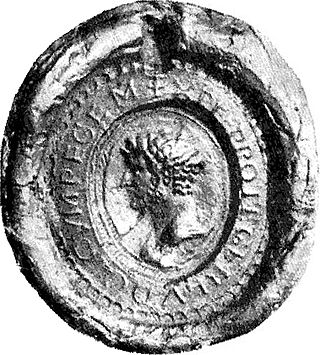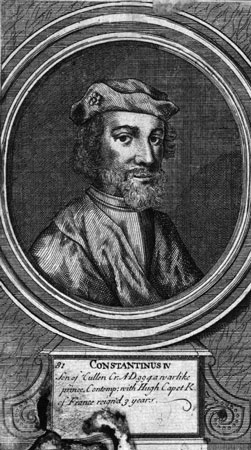
Louis the German, also known as Louis II of Germany, was the first king of East Francia, and ruled from 843 to 876 AD. Grandson of emperor Charlemagne and the third son of Louis the Pious, emperor of Francia, and his first wife, Ermengarde of Hesbaye, he received the appellation Germanicus shortly after his death, when East Francia became known as the kingdom of Germany.

Charles the Bald, also known as Charles II, was a 9th-century king of West Francia (843–877), King of Italy (875–877) and emperor of the Carolingian Empire (875–877). After a series of civil wars during the reign of his father, Louis the Pious, Charles succeeded, by the Treaty of Verdun (843), in acquiring the western third of the empire. He was a grandson of Charlemagne and the youngest son of Louis the Pious by his second wife, Judith.
Máel Coluim mac Cinaeda was King of Alba (Scotland) from 1005 until his death in 1034. He was one of the longest-reigning Scottish kings of that period.

Constantine, son of Cuilén, known in most modern regnal lists as Constantine III, was king of Alba (Scotland) from 995 to 997. He was the son of King Cuilén. John of Fordun calls him, in Latin, Constantinus Calvus, which translates to Constantine the Bald. Benjamin Hudson notes that insular authors from Ireland and Scotland typically identified rulers by sobriquets, noting for example the similarly named Eugenius Calvus, an 11th century King of Strathclyde.

The Duchy of Brittany was a medieval feudal state that existed between approximately 939 and 1547. Its territory covered the northwestern peninsula of Europe, bordered by the Atlantic Ocean to the west, and the English Channel to the north. It was also less definitively bordered by the river Loire to the south, and Normandy, and other French provinces, to the east. The Duchy was established after the expulsion of Viking armies from the region around 939. The Duchy, in the 10th and 11th centuries, was politically unstable, with the dukes holding only limited power outside their own personal lands. The Duchy had mixed relationships with the neighbouring Duchy of Normandy, sometimes allying itself with Normandy, and at other times, such as the Breton–Norman War, entering into open conflict.
Baldwin II was the second margrave of Flanders, ruling from 879 to 918. He was nicknamed the Bald (Calvus) after his maternal grandfather, Emperor Charles the Bald.
Constance was Duchess of Brittany from 1166 to her death in 1201 and Countess of Richmond from 1171 to 1201. Constance was the daughter of Duke Conan IV by his wife, Margaret of Huntingdon, a sister of the Scottish kings Malcolm IV and William I.

Uakari is the common name for the New World monkeys of the genus Cacajao. Both the English and scientific names are believed to have originated from indigenous languages.

The now-extinct title of Earl of Richmond was created many times in the Peerage of England. The earldom of Richmond was initially held by various Breton nobles; sometimes the holder was the Breton duke himself, including one member of the cadet branch of the French Capetian dynasty. The historical ties between the Duchy of Brittany and this English earldom were maintained ceremonially by the Breton dukes even after England ceased to recognize the Breton dukes as earls of England and those dukes rendered homage to the King of France, rather than the English crown. It was then held either by members of the English royal families of Plantagenet and Tudor, or English nobles closely associated with the English crown. It was eventually merged into the English crown during the reign of Henry VII of England and has been recreated as a Dukedom.

The bald uakari or bald-headed uakari is a small New World monkey characterized by a very short tail; bright, crimson face; a bald head; and long coat. The bald uakari is restricted to várzea forests and other wooded habitats near water in the western Amazon of Brazil and Peru.

Bolesław II the Horned, known also as Bolesław II the Bald, a member of the Silesian Piasts, was High Duke of Poland briefly in 1241 and Duke of Silesia at Wrocław from 1241 until 1248, when the duchy was divided between him and his brothers. After the partition, he ruled the Silesian Duchy of Legnica until his death. The second Mongol raid against Poland, led by Nogai Khan, occurred during his reign.

Owain Foel, also known as Owain Moel, Owain the Bald, Owen the Bald, and Eugenius Calvus, was an eleventh-century King of Strathclyde. He may have been a son of Máel Coluim, son of Dyfnwal ab Owain, two other rulers of the Kingdom of Strathclyde. Owain Foel is recorded to have supported the Scots at the Battle of Carham in 1018. Although it is possible that he died in the conflict, no source states as much, and it is uncertain when he died. Owain Foel may be an ancestor—perhaps the father—of a certain Máel Coluim who is described as the "son of the king of the Cumbrians" in the 1050s.
Calvus may refer to:
The counts of Nantes were originally the Frankish rulers of the Nantais under the Carolingians and eventually a capital city of the Duchy of Brittany. Their county served as a march against the Bretons of the Vannetais. Carolingian rulers would sometimes attack Brittany through the region of the Vannetais, making Nantes a strategic asset. In the mid-ninth century, the county finally fell to the Bretons and the title became a subsidiary title of the Breton rulers. The control of the title by the Breton dukes figured prominently in the history of the duchy. The County of Nantes was given to Hoel, a disinherited son of a duke. He lost the countship due to a popular uprising. That uprising presented an opportunity for King Henry II of England to attack the Breton duke. In the treaty ending their conflicts, the Breton duke awarded the county to Henry II.
Idwal is Welsh for "lord of the wall". As a masculine given name, it may refer to the following people:

The House of Estridsen was a dynasty that provided the kings of Denmark from 1047 to 1412. The dynasty is named after its ancestor Estrid Svendsdatter. The dynasty is sometimes called the Ulfinger, after Estrid's husband, Ulf Jarl. The dynasty also provided three medieval rulers of Sweden and one of Norway. Their family coat of arms became the coat of arms of Denmark and thereby influenced the coat of arms of Tallinn and the coat of arms of Estonia.

Ladislas the Bald was a member of the House of Árpád, a grandson of Taksony, Grand Prince of the Hungarians. He is the only known brother of Vazul, a rebellious duke who was blinded on the order of their cousin, King Saint Stephen I of Hungary in 1031 or 1032. Medieval chroniclers, in their effort to conceal that the Kings of Hungary were descended from a prince condemned by the saintly first king, wrote that instead of Vazul, Ladislas was the Hungarian monarchs' forefather. Ján Steinhübel and other modern Slovak historians write that he was Duke of Nyitra under Polish suzerainty, but this theory has not been universally accepted by historians.